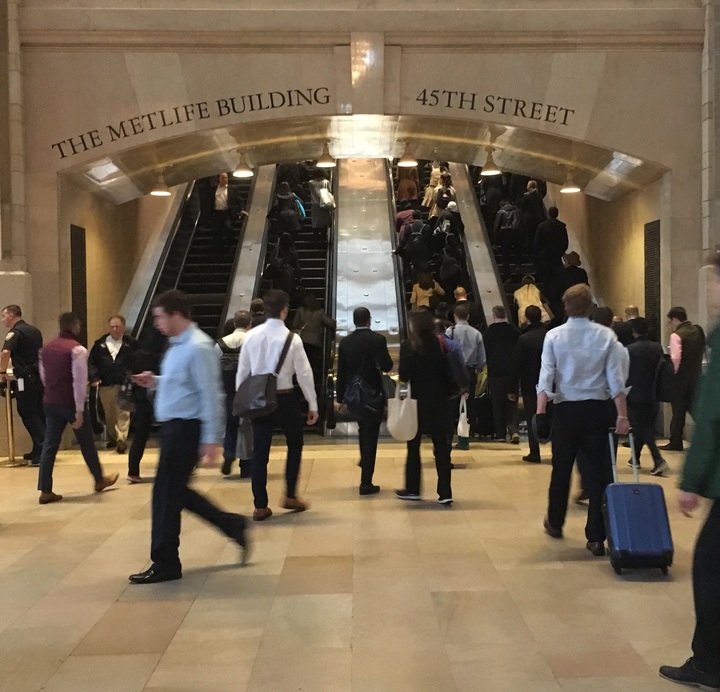Let’s Talk About Escalators

With a population of about 55,000 — about 10% lower than the state capital of Cheyenne — Casper, Wyoming has the dubious distinction of being the second-most populous city in America’s least populous state. Casper isn’t all that different than most other towns of about 50,000 people, though. There are parks, schools, grocery stores, a community college, some museums, and a handful of banks.
But if you visit two of those banks, First Interstate Bank and Hilltop Bank, you’ll see something special: escalators.
Okay, you probably don’t think of escalators as “special” and for good reason; they’re relatively common. Pictured above, for example, are two sets of escalators leading in and out of New York City’s Grand Central Terminal; two pairs among many, many others that are in the building and its attached subway station. If you go to many American malls, you’ll see more of the same. Some multi-level big box stores, like Target and Bed Bath and Beyond, even have escalators which can transport both you and your shopping cart. If you’re in a place with atypically high ceilings and/or you want to move a lot of people up or down a floor — without having to make anyone wait too long, especially — an escalator is a very good, and very common solution.
But that’s not a very common problem in Wyoming. Again, it’s the least populous state, with only 585,000 residents. It is the second-least densely populated state after Alaska (which has huge swaths of unpopulated areas) and, again, its largest cities aren’t all that large. In almost any other state, Cheyenne and Casper would be considered tiny. If they were in the tiny state of Connecticut, for example, they’d be the 8th and 15th most populous cities, respectively, which is to say, they’d be not all that notable.
So if you want to transport Wyomingites from one floor to the next, stairs and elevators make more sense. The former are much easier to maintain; the latter are also cheaper to maintain, and further are accessible by those using wheelchairs, strollers, or who would otherwise struggle with a moving staircase. Ultimately, there just isn’t a huge need for escalators in most situations — there is almost always a better option. And that made one Wyoming resident wonder: just how many escalators are there in the state?
In 2008, a reporter for the Casper Star-Tribune investigated the matter and found only the ones listed at the two banks mentioned above. But those weren’t just the only two sets of escalators in Casper — they were the only two pairs in the entire state. That’s right: Wyoming has more Electoral votes (3) than it has pairs of escalators.
A follow-up article by the Atlantic in 2013 confirmed this fact was still true five years later. Even though the airport in Jackson Hole underwent a significant renovation during the interim period, it didn’t need an escalator. Cheyenne, it turned out, once had an escalator, but it was destroyed when the building (an old J.C. Penney) was demolished. And state-wide, because land is so cheap it makes more sense for big box stores and shopping complexes to build out instead of building up — again, making escalators unnecessary.
So maybe it shouldn’t be surprising that Wyoming has only two sets of escalators. Rather, maybe the question should be: do they really need the two they have?
Bonus fact: The word “escalate” is a verb which means “to increase in intensity, magnitude, etc.,” but you already knew that. You probably figured that the word “escalator” comes from “escalate,” but, nope — it’s the other way around. “Escalator” comes from a combination of the words “elevator” and “escalade,” the latter a noun meaning “a scaling or mounting by means of ladders, especially in an assault upon a fortified place.” The word “escalade” has fallen out of our lexicon for the most part (a model of Cadillac notwithstanding), and “escalate” has since entered. Originally, it meant “to use an escalator.”
From the Archives: The High Life: Why riding an escalator can make us more charitable (if we’re going the right direction).
